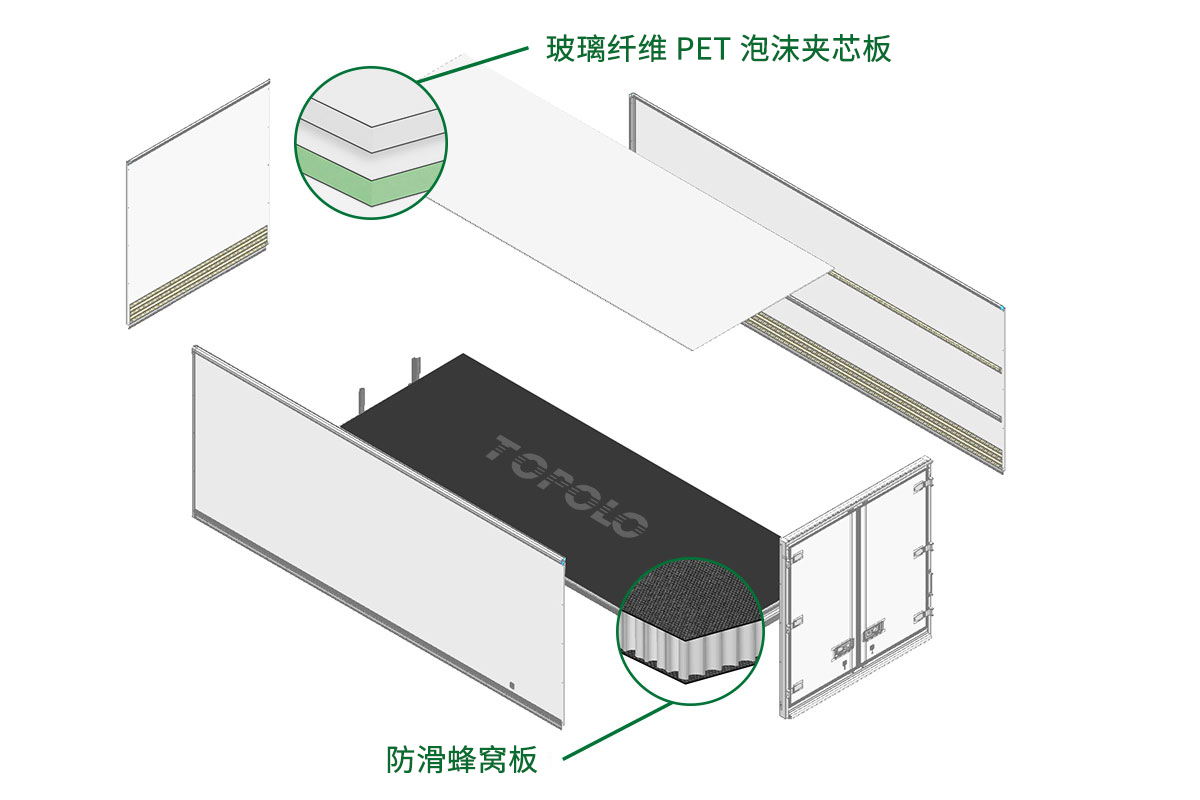Home » Box Truck Bodies » Dry Freight Truck Bodies

使用玻璃纤维 PET 泡沫夹芯板制造干货卡车车身的趋势与日俱增。这种材料因其重量轻、耐用、环保、经济等优点,成为了业界的热门选择。玻璃纤维PET泡沫夹芯板用作厢式卡车车身的墙板、车顶板、门板或隔板。地板通常由防滑热塑性聚丙烯热塑性蜂窝板制成。
环保
PET泡沫是一种高度环保的材料,具有优异的可回收性,可以重复使用,有效减少废弃物对环境的影响。作为最环保的塑料之一,PET的回收过程简单高效,是满足现代可持续发展目标的理想材料。
耐用
玻璃纤维和闭孔 PET 泡沫的结合创造了一种极其耐用的材料,在强度和弹性方面都表现出色。玻璃纤维增强材料增强了结构完整性,而闭孔 PET 泡沫芯材则具有出色的抗冲击性、抗压缩性和环境因素能力。它能够承受恶劣的条件,包括潮湿、化学品和温度变化。
轻
PET泡沫密度低,可以显着降低干车车身的毛重,从而降低油耗,提高运输效率。尽管重量轻,PET泡沫仍然具有足够的刚性和强度。
经济效益
与传统的木材或金属材料相比,PET泡沫的生产成本更低。其高效的利用率和较少的原材料需求进一步降低了生产成本。随着生产技术的进步,PET材料的价格不断下降,使其成为越来越多车身制造商的首选材料,特别适合大规模生产。

规格
| 面临 | 热固性玻璃钢——玻璃纤维增强塑料。 热塑性玻璃钢 (CFRT) – 连续纤维增强热塑性塑料。 |
| 核心 | 原生/再生 PET(聚对苯二甲酸乙二醇酯)泡沫。(密度:60-300kg/m³) |
| 厚度 | 10-50mm. |
| 长度 | ≤12000mm. |
| 宽度 | ≤2800mm. |
原生 PET 泡沫与再生 PET 泡沫
| 特征 | 原生 PET 泡沫 | 再生PET泡沫 |
|---|---|---|
| 材料来源 | 由新的、未使用的原材料制成。 | 由消费后或工业后回收的 PET 制成。 |
| 纯度 | 高纯度,质量稳定。 | 可能含有杂质,具体取决于回收过程。 |
| 机械性能 | 卓越的强度、刚度和耐用性。 | 机械性能可能会有所不同,但通常不太一致。 |
| 对环境造成的影响 | 碳足迹更高,资源更密集。 | 碳足迹更低,更可持续、更环保。 |


热固性玻璃钢与热塑性玻璃钢
| 特征 | 热固性玻璃钢 | 热塑性玻璃钢 (CFRT) |
|---|---|---|
| 材料属性 | 坚固、坚硬、耐热、耐化学腐蚀。 | 柔韧,加热后可重塑。 |
| 耐温性 | 更高的耐热性和耐热降解性。 | 与热固性玻璃钢相比,耐热性更低。 |
| 耐久性 | 在高应力条件下的长期性能方面较不耐用。 | 在极端条件和高压力下更耐用。 |
| 可回收性 | 一旦凝固就不能重熔或重塑,难以回收。 | 可复热重塑,更可回收。 |
| 成本 | 由于生产过程复杂,通常更昂贵。 | 更具成本效益,特别是对于大规模制造。 |



如何加工PET面板
依靠智能CNC加工,将PET面板快速准确地加工成设计的形状和尺寸。面板的每一个细节都得到了完美的呈现。无论是复杂的切割、冲孔还是边缘加工,智能加工设备都能确保加工精度。
如何连接 PET 面板
使用金属型材和铆钉,可以牢固地连接地板、墙板和车顶板,并快速组装成干车车身。这种模块化的组装方式大大缩短了生产时间,降低了人工成本,使车身的各个部位在结构上更加稳定可靠。金属型材的强度保证了连接的牢固性,而铆钉的使用使得组装过程变得简单快捷,大大提高了工作效率。最后,精密组装的车身性能也得到了保证,具有出色的耐用性、抗震性和抗风压性。

要了解有关干货卡车车身复合板应用的更多信息,请联系我们。